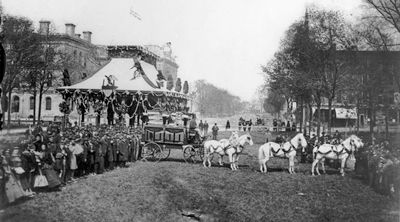by Daniel Hathaway
Commemorations of war anniversaries have fueled the programming of many arts organizations in recent months. Akron Symphony artistic director Christopher Wilkins chose to mark the 150th anniversary of the end of the American Civil War with a sensitively curated program of music by Michael Tippett, Kurt Weill, Paul Hindemith, John Williams and Aaron Copland last Saturday evening, April 11 at E.J. Thomas Hall. While centered on the events of 1865 involving Abraham Lincoln, the program also took note of racial injustice in South Africa and Nazi Germany.
There were many groups and individuals involved in “A New Birth of Freedom.” These included the Akron Symphony and Akron Symphony Chorus, a “Cry, the Beloved Country” Chamber Choir, the Firestone High School Madrigal Singers, six young poetry readers from the Akron School for the Arts and Firestone High School Choral Department, narrators Pastor Eugene Norris II and Mark Auburn, and a quartet of vocal soloists including sopranos Dione Parker Bennett and Angeleina Valentine, tenor Nicholas Modney and baritone Brian Keith Johnson. This was a symphony orchestra concert with a high level of community involvement.
Wilkins began the program with Michael Tippett’s Four Spirituals from “A Child of our Time,” the British pacifist composer’s 1939 oratorio inspired by the Nazi pogrom of November 9, 1938 or “Kristallnacht.” Tippett was inspired by the formal plans of Johann Sebastian Bach’s Passions, and chose to use African American Spirituals in the same way that Bach used Lutheran Chorales. “Steal Away,” “Nobody Knows the Trouble I See, Lord,” “O, By and By” and “Deep River” are cleverly written in many choral layers to suggest slightly-off-kilter rhythms. That technique that only works when they’re performed with the precision and warmth the Akron Symphony Chorus brought to them (as prepared by Maria Sensi Sellner). Soloists added extra layers to the choral texture, especially the expressive soprano Dione Parker Bennett, whose clear, supple vocal embroidery was wonderful.
A complicated stage shift gave Wilkins the opportunity to comment in detail on the rest of the program before the special Chamber Choir filed on to occupy two rows of chairs at the front edge of the stage (they watched Wilkins via monitors in the front row of the house). Kurt Weill’s musical version of Alan Paton’s Cry, the Beloved Country became the composer’s last Broadway show, Lost in the Stars, in 1949. That show yielded a 40-minute “concert sequence” extracted by British musicologist David Drew in 1988 and renamed with the original title of Paton’s novel about racial relations in South Africa just before Apartheid was adopted in 1948.
The music is powerful and affecting. Pastor Norris’s mellifluous reading of the narrative set up a series of scenes brought vividly to life by the chorus, chamber choir, madrigal singers and soloists, enhanced by the Akron Symphony — now operating as a pit orchestra with such Broadway timbres as saxophones, accordion and trap set. Once again, Dione Parker Bennett was full of personality in her solo moments, as was Brian Keith Johnson, who seems to be everywhere, singing everything, and doing so beautifully.
The second half of the program melded three works into a single sequence. During Paul Hindemith’s prelude to When Lilacs Last in the Door-yard Bloom’d — September 1965, and John Williams’s Lincoln, Firestone students Ernest Johnson, Anna Fields, Charles Allgood, Patrick Fields, Jadon Futch and Christopher Humbert proclaimed poems by Walt Whitman with consummate professionalism. Actor and retired University of Akron administrator Mark Auburn was the fine narrator in Aaron Copland’s Lincoln Portrait.
Lasting nearly two and a half hours, this was a long but rewarding evening. Choreography was smooth, the Akron Symphony played with expressive commitment, and singers and reciters gave their all to create something far greater than its constituent parts. Many regional orchestras fall into the lazy habit of building programs around an overture, a concerto and a symphony. The Akron Symphony has taken a different tack with several of its programs this season, and when they click together as successfully as this one did, the results can be amazing.
Photo: A crowd gathers at the catafalque on Public Square in Cleveland to view the body of Abraham Lincoln, 28 April 1865. Western Reserve Historical Society.
Published on ClevelandClassical.com April 14, 2015.
Click here for a printable copy of this article




